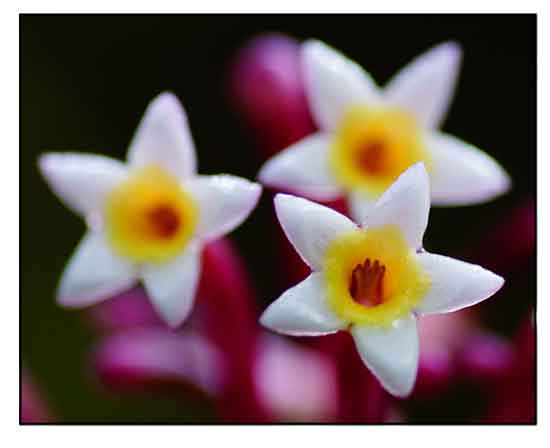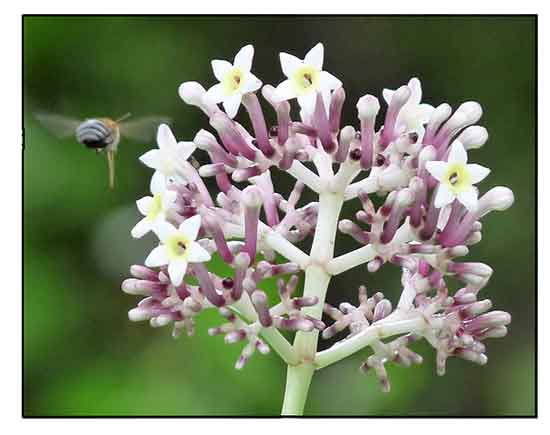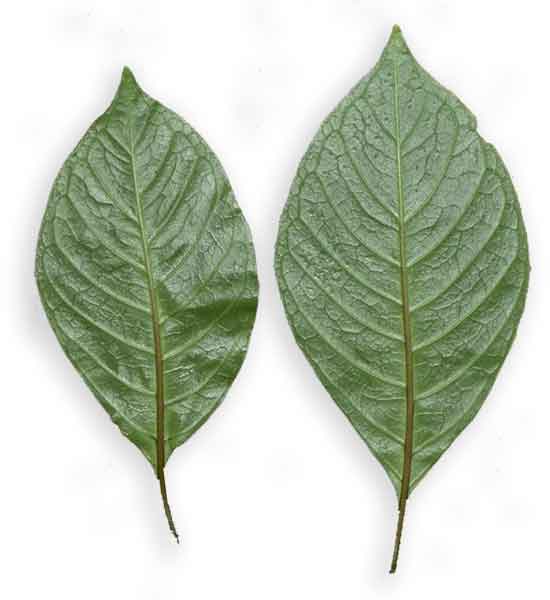 Gen info Gen info
- Chassalia curviflora is a species of flowering plant in the family Rubiaceae. The genus Chassalia includes more than 100 species with paleotropic distribution.
Botany
• Growth form: A small shrub or tree up to 2 m tall. Foliage: Opposite, stalked leaves have leaf blades that are elliptic to inverted lance-shaped, and 6-20 by 2.5-7 cm. Flowers: Flower clusters are 3-5 cm long and develop at the tip of branches. Its white flower petals are 1.5-2 cm long, on a curved floral tube. Fruits: Its 2-seeded fruits are ellipsoid or round, black, and 5-6 mm wide. (2)
• Subshrubs, erect, 1-2 m tall; branches weakly flattened to subterete, glabrous or rarely sparsely puberulent. Leaves opposite; petiole 1-4 cm, glabrous; blade drying membranous to thinly papery and often yellowish green, oblong-elliptic, elliptic, oblanceolate, or narrowly lanceolate, 6-27 × 1.5-7.5 cm, glabrous, base cuneate to  attenuate, apex acuminate to long acuminate; secondary veins 8-17 pairs, without domatia; stipules persistent, united shortly around stem, with interpetiolar portion broadly ovate or broadly triangular, 1.5-4.5 mm, acute or obtuse, entire or usually shortly bifid, with 1 or 2 bristles 0.3-1 mm, often gland-tipped. Inflorescence cymose, pyramidal to rounded, several to many flowered, puberulent; peduncle 1-5 cm; branched portion 3-7 cm; axes weakly flattened; bracts lanceolate to triangular or usually multifid, 0.5-3 mm. Flowers subsessile, trimorphic: with anthers exserted and stigmas included, with anthers included and stigmas exserted, or with anthers and stigmas both exserted. Calyx with hypanthium portion ellipsoid to obovoid, 1-1.5 mm, glabrous; limb 5-lobed, 0.5-1 mm; lobes 0.3-0.5 mm, acute. Corolla white with pink, red, or orange on lobes, outside glabrous to sparsely puberulent and longitudinally ridged to winged along tube then midribs of lobes; tube shallowly to markedly curved, straight or bent at base, 10-15 mm, pubescent inside; lobes (4 or)5, ovate-triangular, 2-2.5 mm, at apex thickened. Infructescence axes becoming swollen and red. Fruit purple, oblate to globose or weakly didymous, 5-7 × 6-9 mm. (Flora of China) attenuate, apex acuminate to long acuminate; secondary veins 8-17 pairs, without domatia; stipules persistent, united shortly around stem, with interpetiolar portion broadly ovate or broadly triangular, 1.5-4.5 mm, acute or obtuse, entire or usually shortly bifid, with 1 or 2 bristles 0.3-1 mm, often gland-tipped. Inflorescence cymose, pyramidal to rounded, several to many flowered, puberulent; peduncle 1-5 cm; branched portion 3-7 cm; axes weakly flattened; bracts lanceolate to triangular or usually multifid, 0.5-3 mm. Flowers subsessile, trimorphic: with anthers exserted and stigmas included, with anthers included and stigmas exserted, or with anthers and stigmas both exserted. Calyx with hypanthium portion ellipsoid to obovoid, 1-1.5 mm, glabrous; limb 5-lobed, 0.5-1 mm; lobes 0.3-0.5 mm, acute. Corolla white with pink, red, or orange on lobes, outside glabrous to sparsely puberulent and longitudinally ridged to winged along tube then midribs of lobes; tube shallowly to markedly curved, straight or bent at base, 10-15 mm, pubescent inside; lobes (4 or)5, ovate-triangular, 2-2.5 mm, at apex thickened. Infructescence axes becoming swollen and red. Fruit purple, oblate to globose or weakly didymous, 5-7 × 6-9 mm. (Flora of China)
Distribution
- Native to the Philippines.
- Also native to Andaman Is., Assam, Bangladesh, Borneo, Cambodia, China South-Central, China Southeast, East Himalaya, Hainan, India, Jawa, Laos, Lesser Sunda Is., Malaya, Myanmar, Nepal, Sri Lanka, Sumatera, Thailand, Tibet, Vietnam. (1)
 Constituents Constituents
- Phytochemical screening of ethanolic extract of leaves revealed alkaloid, carbohydrate, saponins, phytosteroids, triterpenoids, phenolic compounds, flavonoids, fixed oils and fats. (3)
- Physico-chemical and biochemical analysis of crude drug powder of stem yielded foreign content 0.313%, moisture 11.333%, total ash 11.416%, acid soluble ash 56.83%, water soluble ash 15.05%, and alcohol soluble ash 10.595. Biochemical content yielded high dry matter 88.666%, carbohydrate 63.027%, crude fiber 14.693%, crude protein 13.125%, total ash 11.416%, moisture 1.33, and crude fat 1.099%. (3)
- Study of fresh leaves for essential oil by hydrodistillation, GC, and GC-MS yielded a total of 27 components in the EO, which made up 91.2% of the total oil. The EO was composed mainly of caryophyllene oxide (22.4%), ß-caryophyllene (16.5%), germacrene D (11.8%), (E)-nerolidol (9.2%), and elemol (5.5%). Other minor components more than 2% were δ-cadinene (3.2%), α-cadinol (2.8%), borneol (2.7%), sabinene (2.5%), t-muurolol (2.2%), and α-humulene (2.0%). (see study below) (6)
- Study of petroleum ether, ethyl acetate, and methanol extracts for total phenolic content showed 7.84, 10.84, and 14.84 mg GAE/g, respectively, and total flavonoid content (TFC) of 7.64, 10.64, and 14.64 mg QE
/g extract, respectively. (see study below) (9)
- GC-MS analysis of leaves and flower extracts showed 10 highest peak area (%) of phytochemical in all samples were
bis (2-ethylhexyl) ester (34.64%), Cyclotrisiloxane, hexamethyl-(31.14%),(Phenylthio) acetic acid, 1-adamantylmethyl ester (30.90%), Hexanedioic acid, Cyclononasiloxane, octadecamethyl-(18.357%), Oleic Acid (16.56%), n-Hexadecanoic acid (15.23% and 14.15%), 4H-Pyran-4-one, 2, 3-dihydro-3, 5-dihydroxy-6-methyl-(16.43% and 12.98%) and Trichloromethane (11.03%). (see study below) (10)
Properties
- Studies suggest neuropharmacological, acaricidal, acetylcholinesterase inhibitory, anti-inflammatory, analgesic, angiotensin-converting enzyme inhibitory, antidepressant, antioxidant, cytotoxicity, antihypertensive, antiproliferative, protease inhibitory, hepatoprotective properties.
Parts used
- Leaves, roots. flowers.
Uses
Edibility
- No report on edibility.
 Folkloric Folkloric
- No reported folkloric medicinal use in the Philippines.
-
In India, used by the kani tribes of Wayanad for treatment of jaundice. Juice of leaves boiled with oil used for ear and eye diseases, ulcer, and sore throat. Tribes of Mananthavady use the whole plant for skin diseases. Root decoction used as remedy for phlegm, rheumatism, and pneumonia. Decoction of leaves given for colic pain. Roots used as antidote for snake bites. (3)
- In Malay traditional medicine, used for treatment of malaria, coughs, wounds, and ulcers. (3)
- Chakma tribes of Bangladesh use poultice of crushed leaves for treating snake and insect bites. (3)
- Decoction of roots used for treatment of malaria; roots
and leaves used for treatment of wounds and ulcers, applied externally to relieve headaches; root paste applied topically to treat wounds and pimples. (7)
- In Kerala, India, used for menstrual pain and high blood pressure.
Studies
• Neuropharmacological Effects / Leaves: Study evaluated the neuropharmacological properties if ethanol, acetone, and ethyl acetate leaf extracts of Chassalia curviflora in Swiss albino mice using doses of 50, 100, and 200 mg/kbw in thiopental sodium-induced sleeping time (TSIST), and doses of 100 and 200 mg/kbw in other tests. In TSIST at doses of 100 and 200, there was marked reduction in initiation and sleep length (p<0.05) and significant decrease (p<0.05) in unconstrained locomotor and explorative activities in both hole crossing and open field tests. Extracts increased sleeping time dose-dependently and reduced number of head dips in hole-board test. Best neuropharmacological effects were seen with dosage of 200 mg/kg. Results showed leaves have strong anti-depressant and hypnotic effects. (4)
• Acaricidal / Leaves: Study evaluated the acaricidal effect of C. curviflora on engorged female ticks of R. (B.) annutatus. Ethanol extracts at different concentrations (10% to 1.25%) was tested against ticks using adult immersion test (AIT). A 10% extract revealed 43.76% inhibition of fecundity (IF) and 29.16% pf adult tick mortality. Preliminary screening revealed high contents of saponins, alkaloids, and flavonoids. HPTLC profiling showed presence of 14 polyvalent compounds. Results revealed presence of compound in the extract that may influence reproduction system of female ticks. (5)
• Acetylcholinesterase Inhibitory Activity / Essential Oil: Study of leaves for essential oil by hydrodistillation, GC, and GC-MS yielded a total of 27 components in the EO, which made up 91.2% of the total oil. The EO was composed mainly of caryophyllene oxide (22.4%), ß-caryophyllene (16.5%), germacrene D (11.8%), (E)-nerolidol (9.2%), and elemol (5.5%). The essential oil showed significant activity against acetylcholinesterase with percentage inhibition of 70.5%. In previous studies, AChE inhibition has been attributed to presence of ß-caryophyllene and caryophyllene oxide. (see constituents above) (6)
• Anti-Inflammatory / Analgesic / Roots and Leaves: Study evaluated ethanolic extracts of leaves of roots for invivo anti-inflammatory and analgesic and invitro anti-lipidperoxidative activities. Both leaf and root extract doses of 50, 100, and 200 mg/kg significantly reduced formation of edema induced by carrageenan. Results were comparable to reference drug, indomethacin. In acetic-induced writhing, the extracts showed significant analgesic activity evidenced by reduction in number of writhes. Extracts also inhibited MDA production in FeCl2-AA treated rat liver invitro, suggesting significant anti-lipid peroxidative efficacy. Acute toxicity study suggested non-toxic nature of the extract in test dose ranges. (7)
• Angiotensin Converting Enzyme Inhibition / Review: Review summarized the medicinal plants in Southeast Asian countries that have angiotensin-converting enzyme inhibitory activity that is useful for treating hypertension. Thirty-four articles on ACE inhibition activity of 76 medicinal plants were found and reviewed. Ten plants including Chassalia curviflora were found to exhibited strong ACE inhibitory activity in vitro. C. curviflora water leaves extract and methanol flower extract exhibited ACE inhibitory activity with IC50s of 4.96 µg/mL and 4.06 µg/mL, respectively. Bioactive compounds such as 3’,4’, dihydroxy-3-5 dimethoxy flavone-7-Oβ-rhamnose and quercetin-3-O-glucoside showed the highest potency in exhibiting the ACE inhibition activity in the review. (8)
• Cytotoxicity: Cytotoxicity activity by brine shrimp lethality assay showed LC50 of 922.44 µg/mL, 242.03 µg/mL, 178.75 µg/mL, 27.87 µg/mL for standard vincristine, petroleum ether extract, ethyl acetate extract, and methanol extract of C. curviflora, respectively. The lowest LC50 of methanol extract indicates more cytotoxicity among all. (9)
• Antioxidant: Study evaluated antioxidant potential using DPPH free radical scavenging assay, total phenolic content (TPC), and total flavonoid content (TFC). DPPH assay showed IC50s of 89.202, 531.44, 321.548, 59.215 µg/mL for ascorbic acid (standard), petroleum ether, ethyl acetate, and methanol extracts, respectively. Notably, IC50 of the methanol extract indicates more antioxidant potential than the standard. (see constituents above) (9)
• Antihypertensive / Leaves and Flowers: Study evaluated the antihypertensive activities of hot water and methanol extracts of leaves and flowers of C. curviflora. The hot water extract of flower showed highest antihypertensive activity with % ACE inhibitory activity of 95.50% with IC50 of 3.71 µg/ml. Results showed leaves and flowers have potential as antihypertensive agent. (see constituents above) (10)
• Anticancer / Anthelmintic / Neuropharmacological / Leaves: Study evaluated the anticancer, anthelmintic, and neuropharmacological activities of methanol extract of leaves of C. curviflora. Anticancer testing using cell viability assay showed 29.16% inhibition with concentration of 1000 µg/mL. In anthelmintic activity testing against earthworms Pheretima posthuma using fresh leaf juice showed time of paralysis starting at 8 min 19s and ending at 38 min 21 s, compared to albendazole with 22 min 36 s and 75 min 3 s, suggesting considerable anthelmintic activity of the plant. Neuropharmacological testing by hole cross and light/dark box tests at doses of 200 and 400 mg/kg in Swiss albino mice showed significant decrease in locomotor activity in hole cross test indicating significant antidepressant property, with matching activity in light/dark box text. (11)
• Antiproliferative /Alkaloids of Roots: Study evaluated the antiproliferative effects of total alkaloids isolated from roots of C. curviflora. MTT assay evaluated total alkaloids against three cancer cell lines viz., liver cancer cell line A549, breast cancer cell line MCF7, and ovarian cancer cell line HeLa. Significant antiproliferative effects was observed in 549 cells with IC50 of 3.59 µg/mL. Cell cycle analysis showed cell arrest in sub G0 phase. Annexin V-FITC assay revealed 27.4% cells were in early apoptosis and 7% cells in late apoptosis. Results showed total alkaloids of roots possess significant antiproliferative and apoptotic activity. (12)
• Acute Toxicity Study / Roots: Study evaluated the acute toxicity of C. curviflora roots in albino rats following OECD 425 guidelines. Test drug was administered in doses of 175, 550, up to 2000 mg/kg. All animals in the treatment group survived through the 14-day observation period, with no physical or behavioral changes except mild increase in motor activity in one rat at dose of 2000 mg/kg. Results suggest the aqueous extract of root is safe for internal administration in the acute toxicity study. (13)
• Natural Dye for Dye-Sensitized Solar Cells: Study evaluated the use of natural dyes from Chassalia curviflora (CCE) extracted to provide bioactive chemicals for the development of dye-sensitized solar cells (DSSCs). The dyes improved adsorption properties on TiO2 indicated by the presence of functional groups, bond stretching, and bending features. Phytochemical components of the dye are shown to be crucial in trapping electrons and holes, hence reducing charge recombination and promoting enhanced charge transport towards titanium dioxide transmission group. Dipping time analysis revealed a 15-minute duration is optimal for achieving a 0.146% photoelectric conversion efficiency in DSSCs utilizing CCE. (14)
• Anti-Hepatotoxic / CCl4-Induced Toxicity / Leaves and Roots: Study evaluated the ethanolic extracts of roots and leaves for anti-hepatotoxic and antioxidant effects in experimentally induced carbon tetrachloride liver injury. Root and leaf extracts in doses of 50, 100, and 200 mg concentrations (p≤0.05) significantly reduced elevated hepatic enzymes (SGOT, SGPT, alkaline phosphatase), serum bilirubin and cholesterol levels induced by CCl4. Antioxidant enzymes superoxide dismutase (SOD), catalase (CAT), and non-enzymatic reduced glutathione (GSH) levels were increased, while malondialdehyde (MDA) level was reduced. Root extract effected enzyme changes in a dose dependent manner, more than leaf extracts. Results were comparable to silymarin. Histopathological studies supported the biochemical findings. Acute toxicity study suggests safety for pharmacologic uses up to 2000 mg/kg. (15)
• Cytotoxic Effects of Plant Protease Inhibitors on Cancer Cell Lines: Protease inhibitors show potential in cancer therapy by targeting dysregulated proteolytic activity linked to tumor progression and metastasis. Study screened 26 plant extracts for trypsin inhibitory and cytotoxic activity. Twelve extracts contained trypsin inhibitors and 18 showed cytotoxicity to HT29 cell line. When plant extracts containing protease inhibitors were subjected to proteinase K digestion, the protease inhibitory activity and cytotoxicity were reduced. C. curviflora showed decrease in trypsin inhibition as well as cytotoxicity when subjected to proteinase K treatment, indicating a correlation between cytotoxicity and trypsin inhibition or other proteinaceous components present in the trypsin inhibitor containing extracts that may be contributing to cytotoxicity. (16)
Availability
Wild-crafted.
Seeds in the cybermarket. |

![]()







